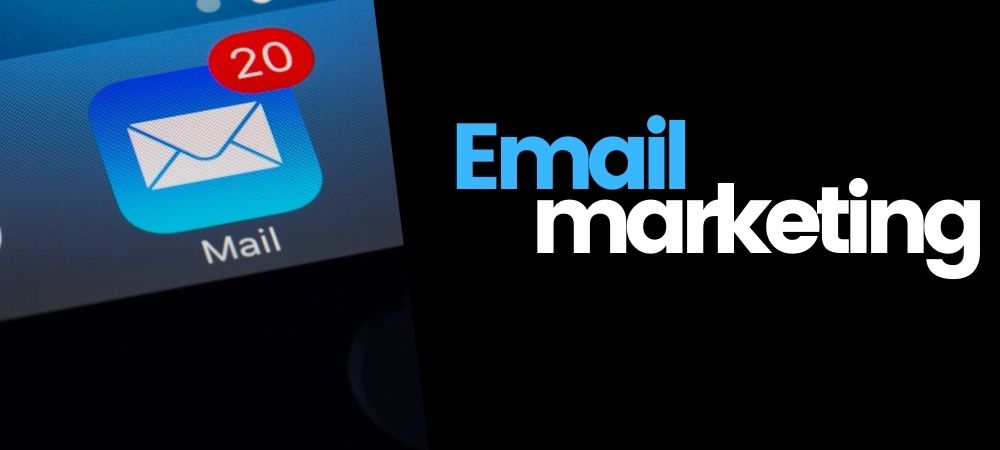According to RNL’s 2021 E-Expectations Trend Report, email marketing is a preferred communication method for today’s students. 97% percent are willing to share email addresses—and more than half prefer email as a response after requesting more information.
Email marketing can help schools to:
- Boost enrollment
- Build strong relationships with prospects
- Elevate school brand
- Increase student retention
Email marketing also yields a high return on investment (ROI): For every $1, schools can expect to receive up to $44 in return.
Standout with compelling content
Today’s students are also inundated with information, with the average Gen-Zer utilizing 5 different devices each day. To reach prospects, schools must use preferred communication methods, like email marketing, and deliver compelling and creative content.
How can schools approach email marketing to achieve a high ROI? We’ve compiled the following 10 tips and best practices to help.
1. Segment and automate
Before designing content, identify and segment your target audience. A targeted approach allows for more customized and relevant content—a key tactic for boosting email engagement.
Consider utilizing available prospect data, like age or program of interest, to segment email lists. Criteria might include:
- Major or school
- Extracurricular interests
- Demographics, such as age, gender or employment status
To save time and map your strategy, consider prescheduling or automating emails. Marketing automation is especially helpful for drip campaigns.
If you’re considering sending several emails over a period of time—especially with the purpose of lead nurturing—a drip campaign could be the best approach.
2. Personalize as much as possible
According to email marketing firm Emma, nearly 75% of marketers say personalization boosts customer engagement—a fact especially true for Gen Z, a cohort that values highly personalized brand experiences.
In email marketing, a few personalization ideas include:
- Using prospects’ first names
- Providing resources on specific program of interest
- Using images which reflect prospects’ demographic
- Addressing email from a specific person
Check out this example from Charles Sturt University (CSU):
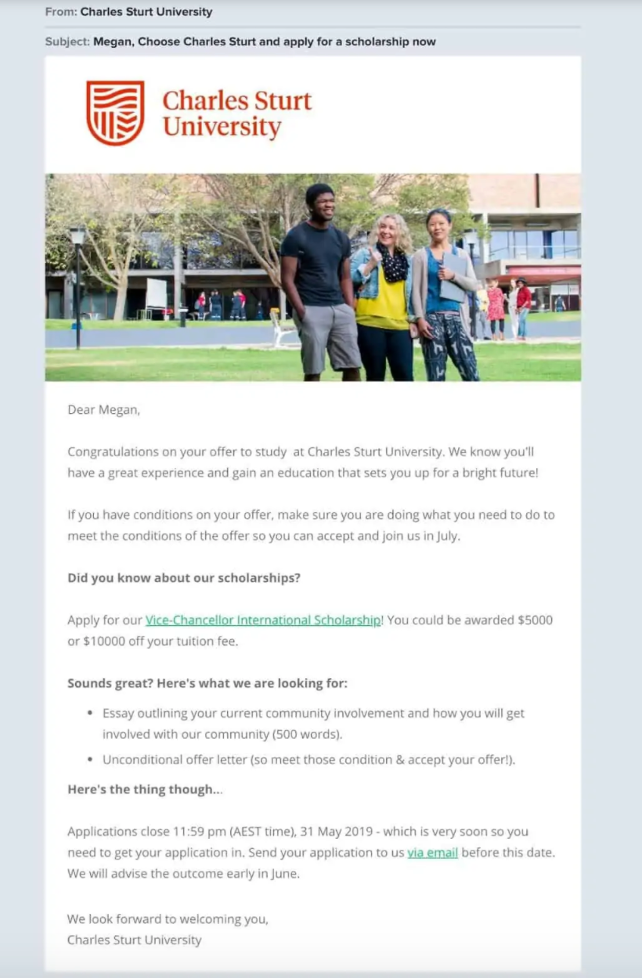
CSU personalizes the email by using the prospect’s name in both subject line and salutation. CSU also includes photos of students of a similar demographic on campus and provides resources specific to Megan’s needs.
Try to align emails with the student journey as much as possible. Provide resources that align with a student’s needs at their specific stage, as in the example above.
3. Prioritize video and compelling images
Including videos in email can increase click rates by up to 300%. As Gen Z’s favored content source, video marketing has also proven to influence enrollment decisions by nearly 70%.
Depending on email marketing goals, videos include:
- Brand stories illustrating school mission and values
- Campus tours
- Sample course content, like clips of lectures
- Application how-tos
- Student or alumni testimonials
Video storytelling helps distinguish brand by sparking emotional connection and capturing ethos—impact difficult to achieve with static images alone. Check out this brand story video from Berkley as an example:
Berkeley demonstrates discovery and innovation, two of its brand values, by showing students and faculty in action. The video helps elicit emotion with music, inspiring narration and dynamic video clips.
Images are also key for boosting email engagement. Try to select images that highlight special attributes of your school and brand. Ideas include:
Be sure to add image alt text, which provides a short text descriptor for each picture. Alt text helps sustain engagement if images don’t load—and is an important accessibility practice for those with visual impairments.
4. Avoid the spam folder
Emails flagged as promotional are often relegated as junk mail. To avoid prospects’ spam filters, consider the following tips:
- Address emails from a specific person or department in “from” and “reply-to” fields
- Personalize subject lines and salutations, which helps demonstrate a personal relationship
- Include an “add to your address book” CTA
- Use email marketing software for a stronger IP address
Engagement rate also greatly impacts where an email lands—meaning well-designed content is essential for successful delivery. High open and click-through rates signal your content is worth reading and belongs in inboxes, not spam folders.
5. Streamline across departments
If other departments also manage student communications, be sure to coordinate content calendars. A streamlined, cross-departmental strategy helps ensure clear and effective prospect communication.
Consider setting regular meetings to discuss ongoing email marketing plans. You can use the following as a checklist for evaluation:
- Is email distribution spread evenly over a period of time?
- Does email timing conflict?
- Is content repetitive or contradictory?
- Is school brand consistent?
6. Optimize for mobile—and multiple device
Studies show more than 70% of people read email via mobile devices. To effectively reach prospective students, marketing emails must be mobile-optimized.
Ensure your email marketing software offers a mobile-responsible design. For larger campaigns, you might consider different templates customized per device (smartphone, laptop, tablet, etc).
When designing emails, consider the following mobile-friendly tips:
- Make sure text is large enough and readable
- Use CTA buttons for clickability versus links
- Prioritize image use
- Adjust CSS code for different email providers, like Outlook or Gmail
- Test on multiple devices before sendout
Check out this well-designed mobile email from Washington University School of Law
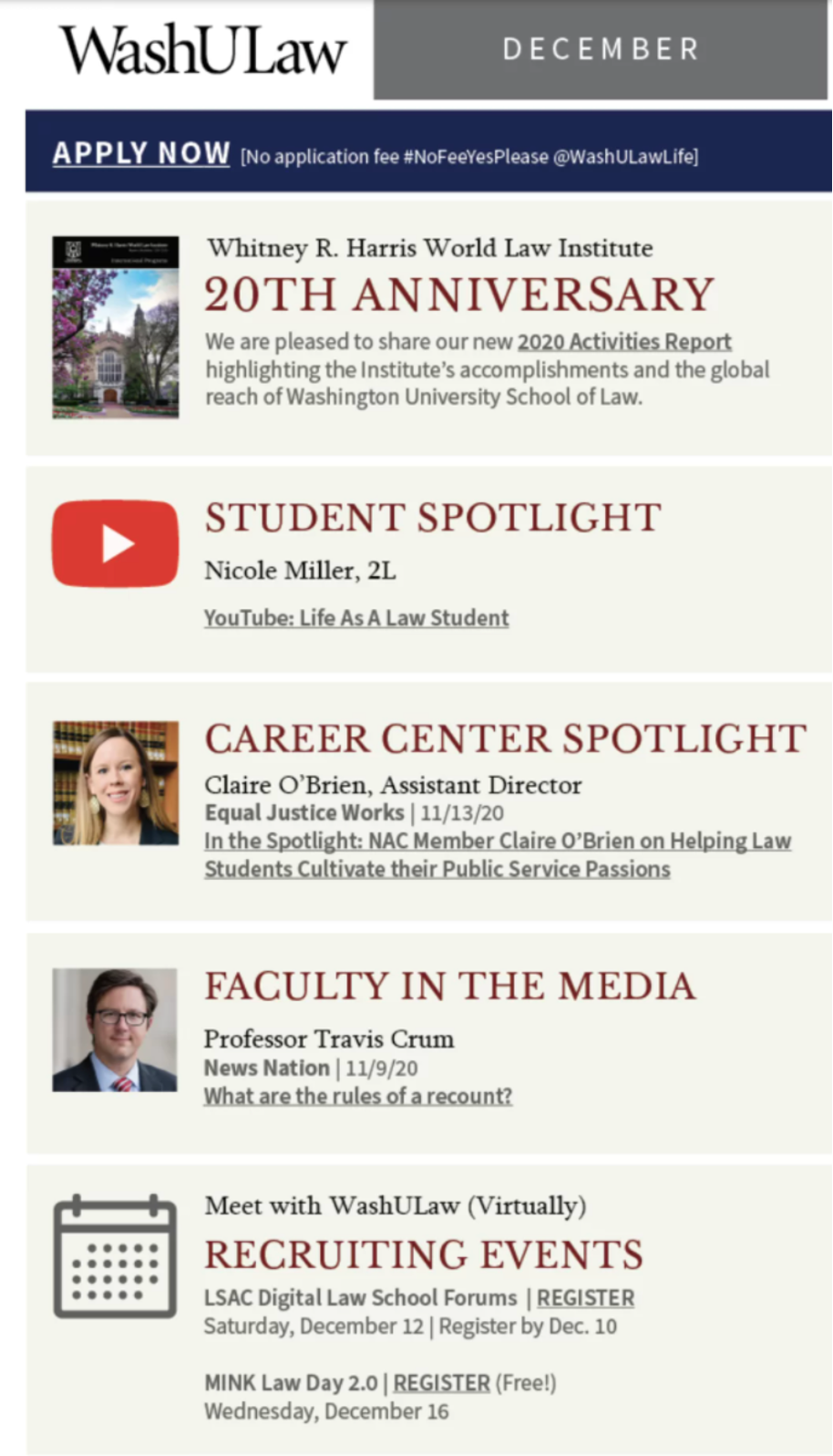
WashU structures content in evenly spaced vertical boxes and sizes text appropriately for mobile users. While the school doesn’t use large CTA buttons, WashU does utilize images and ensure links are easily readable and accessible. (Credit: HEM Solutions)
7. Write compelling subject lines and CTAs
Barnes and Noble reports 42% of students preview emails before opening, meaning a compelling subject line could make or break your campaign.
Consider the following best practices:
- Keep subject lines short, under 60 characters
- Use action words to induce curiosity (i.e. explore, discover, inspire)
- Include preview text
- Personalize, which can generate 50% higher open rates
To conclude your email, include an inspiring call to action. Every email should include a CTA with clear next steps to direct readers.
A few CTA best practices include:
- Use action words
- Format as a button
- Use contrasting colors to help standout
Check out these two CTAs from educations.com emails.
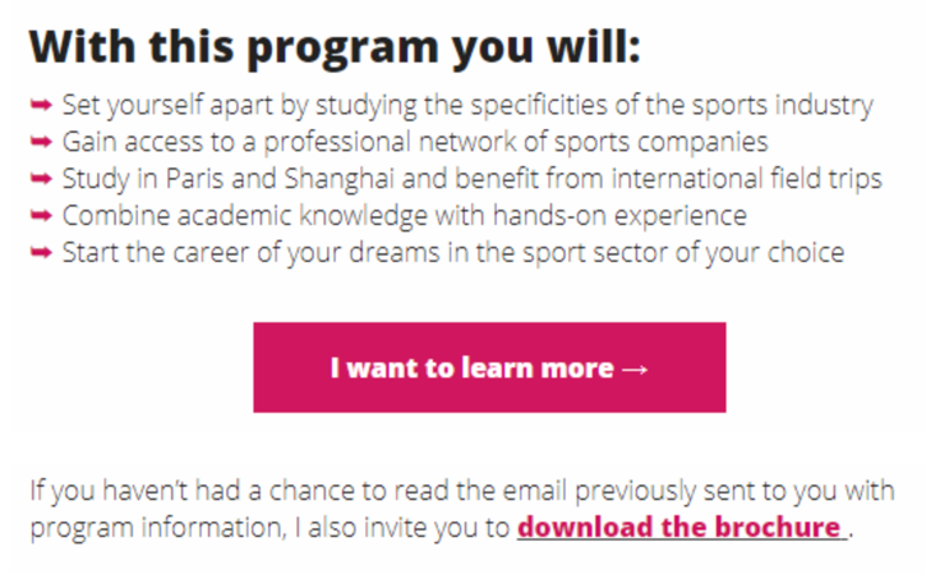
This email’s CTA, intended for prospects interested in a specific program, helps inspire action with a personal statement of intent: “I want to learn more.” The CTA is formatted as a button and shaded bright pink to standout from the rest of the text.
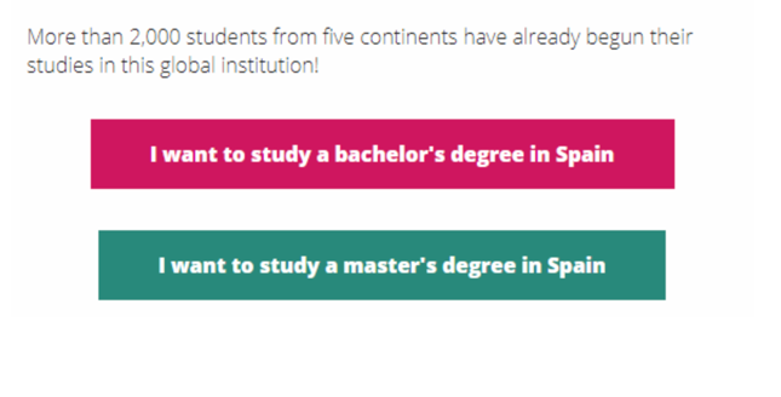
Check out this second example for other action-oriented ways to write a CTA. Note the color differences for added effect.
8. Integrate with other digital marketing efforts
You can optimize the effectiveness of your email marketing by integrating it with other efforts, like social media and pay-per-click (PPC) advertising.
For social media, today’s students prefer Instagram, Snapchat, and YouTube. Prioritize cross-promotion on these platforms by:
- Including social media buttons or links in emails
- Promoting newsletter signups on social media
- Repurposing email content on social media, and vice versa
Take a look at this example from Syracuse University.
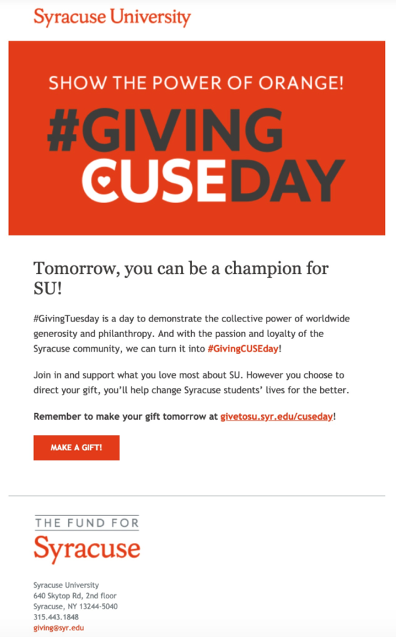
Syracuse includes a branded hashtag #GivingCUSEday so recipients can share on a social media channel of choice. This integrated strategy helps amplify efforts both through email marketing and social media. (Credit: Emma)
PPC also offers a strategic opportunity to integrate marketing efforts. Digital ads on platforms like Google and Facebook are especially helpful for generating new leads.
To integrate with PPC ads, consider:
- Setting up email address form as a primary conversion goal
- Capturing buyer’s email address during transactions
- Directing prospects to a landing page which collect email addresses
9. Get strategic with timing
Strategically timed emails are essential for visibility in people’s packed inboxes. The more convenient and relevant your timing, the higher likelihood a prospect will open.
Per a WordStream study, Tuesday, Wednesday, and Thursday are the most popular email send days. Other timing tips include:
- Sending between 9-11 a.m. or 1-3 p.m.
- Testing different times and dates with various segments
- Staying mindful of time zone differences
Be sure to double-check where prospects are located. A student from across the country or overseas will need a different send-out schedule than someone living locally.
Some CRMs allow you to check recipient time zones and pre-schedule emails based on location. Alternatively, consider segmenting lists by location and managing delivery manually.
10. Test, monitor and optimize
After sending each email, be sure to track results and performance trends. Set aside a regular time to evaluate how to improve strategy and approach.
Consider the following performance indicators:
- Open rate
- Click through rate
- Number of unsubscribes
- Response rate
Knowing specifics is also important, especially when focused on increasing conversions. Consider evaluating specific email elements, such as:
- Subject lines
- Formatting of email
- Graphics and pictures
- Send times
A/B testing, the practice of sending two different emails to the same audience segment, can be especially helpful. Consider creating two different designs to hone which elements work for your audience, and what ultimately inspires action.
Well-designed and creative email marketing helps cut through the digital sphere and effectively engage prospective students. Whether honing your higher education email marketing or launching a program, we hope these tips help boost your ROI—and ultimately, your school’s enrollments.
Editor’s note: This post is the first in a two-part series on email marketing for colleges. Click here to check out the companion post, “5 Steps to Boost Enrollments with Email Drip Campaigns.”
Editor’s note: This post is part of our two-part series on email marketing. Click here to check out the companion post “10 Tips to….”[JM1]





